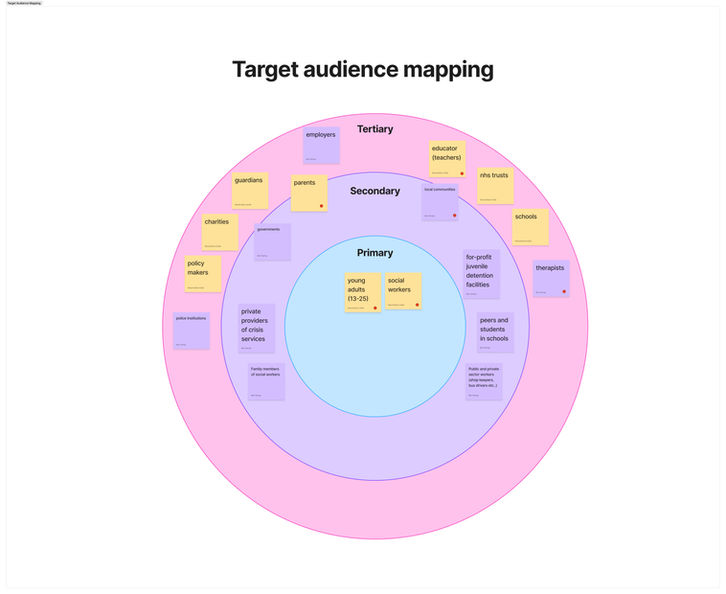How I Used AI to Create an AI for Better Help
Designing Echo, an AI assistant inside SocialHeads to transform social care through intelligent support.

Project Overview
SocialHeads is a secure digital platform designed specifically for social care - a safe alternative to everyday messaging apps that meets safeguarding standards while remaining approachable for young people.
Echo is the AI-powered assistant at its heart, designed to fill critical gaps in care while supporting overworked social workers with intelligent tools that save time and highlight risks.
My Role: Lead Product Designer | Research, UX/UI, AI Integration, Prototyping
Timeline: 6 months | Team: 4 designers + SME advisors
Tools: Figma, Miro, GPT-4, Claude, Notably, Lovable
Understanding the Problem
Research Approach
I conducted in-depth interviews with social workers, young people, and NHS professionals, using AI tools to synthesize insights at scale. Used Notably AI to cluster qualitative data from 50+ interviews, GWI Spark to validate findings with global behavioral data, and journey mapping to identify critical pain points.
Key Insights
Young People:
-
Need someone to talk to "in the moment" - not next week's appointment
-
Want judgment-free conversations without formal processes
-
Often need support outside traditional office hours
Social Workers:
-
Spend 3+ hours daily on admin instead of direct care
-
Manage scattered notes across multiple systems
-
Experience emotional burnout from constant high-stakes decisions
The System:
-
Warning signs get buried in paperwork
-
Risk assessments happen too late
-
Communication gaps lead to missed interventions

The Spark: Why Echo?
The breakthrough came from a simple observation during my research:
"I wish I had more time to actually be there for the kids." - Social Worker Interview
Young people need help at 2am. Social workers can't be available 24/7. But what if AI could echo their care and presence during those crucial gaps?
Echo was born from this insight: AI shouldn't replace human empathy, it should amplify it.
The Solution: Echo AI Assistant
Echo works on two levels, providing complementary support for both young people and social workers.
For Young People
-
24/7 Availability: Safe, empathetic chat companion when crisis hits
-
Non-judgmental Space: AI trained to listen without triggering formal processes
-
Crisis Support: Intelligent routing to human help when needed
For Social Workers
-
Smart Summaries: AI-generated case updates save 2+ hours daily
-
Risk Intelligence: Color-coded alerts highlight concerning patterns
-
Streamlined Workflow: All information in one place, 40% faster case prep
For the System
-
Early Intervention: Risks flagged before they become crises
-
Resource Optimization: More time for human connection, less for admin
-
Data-Driven Insights: Understanding patterns across cases
Design Process
Research & Synthesis
Mixed-methods research combining human interviews with AI-powered analysis. Used GPT-4 to analyze interview transcripts, identifying patterns manually missed.
Ideation & Concept Development
AI-assisted brainstorming using Miro AI to structure ideas, then human validation with SMEs. Echo as "empathy amplifier" rather than replacement.
Prototyping with AI
Used GPT-4 and Claude to simulate Echo's responses, testing tone and safety protocols without building full technical infrastructure.
Design & Testing
Parallel design streams with constant cross-validation between user groups. Mock conversations with AI agents to simulate real usage patterns.
Storyboard, Journey Mapping & low-fidelity wireframes
 |  |  |  |  |  |  |  |  |  |  |
|---|---|---|---|---|---|---|---|---|---|---|
 |  |
Key Features & Design Decisions
Dashboard for Social Workers
Chat Interface for Social Worker
Design Philosophy: Essential information at a glance, with drill-down for details.
Key Elements:
-
TL;DR Section: AI-generated case summaries
-
Risk Snapshot: Color-coded alerts (green/amber/red)
-
Next Steps: Intelligent task prioritization
-
Smart Notifications: 50% reduction in alert noise
Chat Interface for Young People
Design Philosophy: Familiar messaging experience with enhanced safety.
Key Elements:
-
Empathetic Tone: Copy refined through AI testing for warmth and safety
-
Visual Cues: Subtle indicators when conversations are being monitored
-
Crisis Protocols: Seamless handoff to human support when needed
Results & Impact
Quantifiable Outcomes
-
Time Saved: 3+ hours daily per social worker (validated through user testing)
-
Intervention Speed: 60% faster identification of high-risk situations
-
Administrative Burden: 40% reduction in case preparation time
Qualitative Impact
-
Young People: "Finally feels like someone's listening, even at 3am"
-
Social Workers: "I can focus on being present instead of note-taking"
-
System: Earlier interventions, fewer crisis escalations
Proof of Concept
-
Built interactive prototypes that demonstrated AI conversation flows, tested with 20+ social workers and validated the time-saving projections through workflow analysis.
Storyboard, Journey Mapping & low-fidelity wireframes
 AI Case 3 |  AI Case 2 |  AI Case |  Profile_About |  Profile_Schedule |
|---|
Key Learnings
AI Amplifies, Doesn't Replace
The most successful AI solutions enhance human capabilities rather than substituting them. Echo works because it makes social workers more effective, not redundant.
AI-Powered Design Process
Using AI throughout research, design, and testing accelerated development while maintaining human-centered outcomes. AI tools became collaborative partners, not just production aids.
Safety Through Intelligence
In sensitive contexts, AI can actually improve safety by consistently monitoring for risks that exhausted humans might miss.
No child unheard.
No worker unsupported.
Echo represents a new paradigm in social care technology, where AI doesn't just automate tasks but genuinely supports human connection. The project showed that when we design AI to complement rather than compete with human empathy, we can create tools that make care systems more responsive, workers less burned out, and young people truly heard.
This case study demonstrates how AI can be thoughtfully integrated throughout the design process to create more empathetic, effective solutions for complex social problems.









